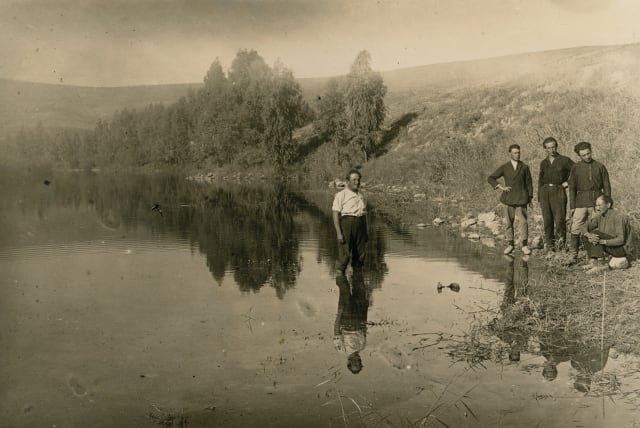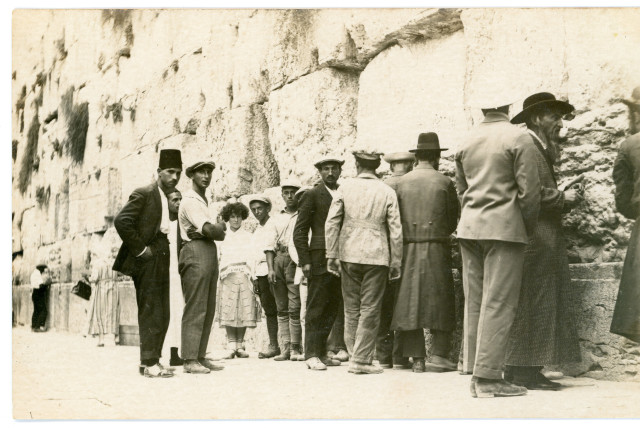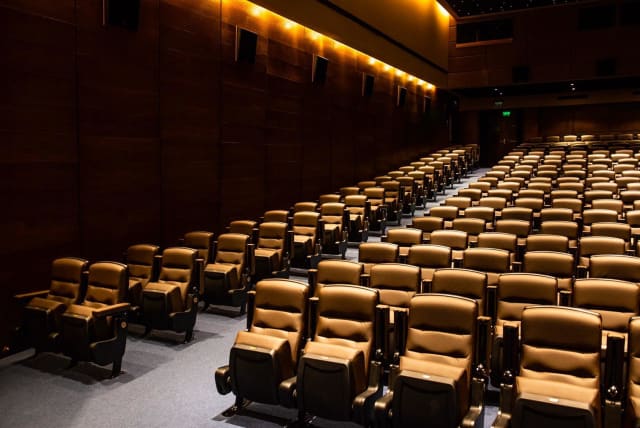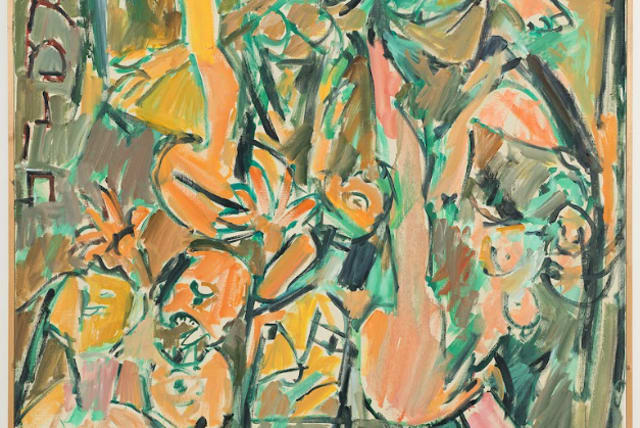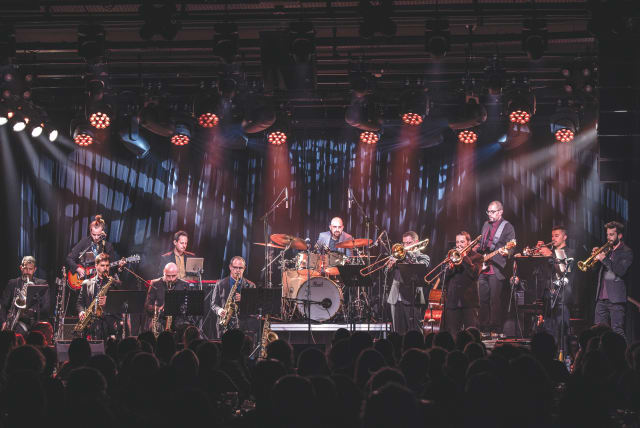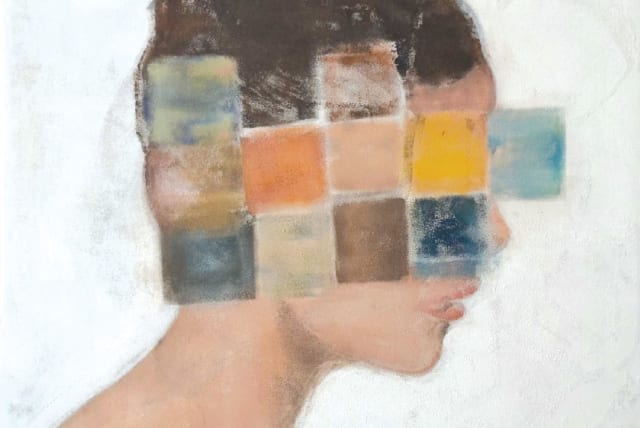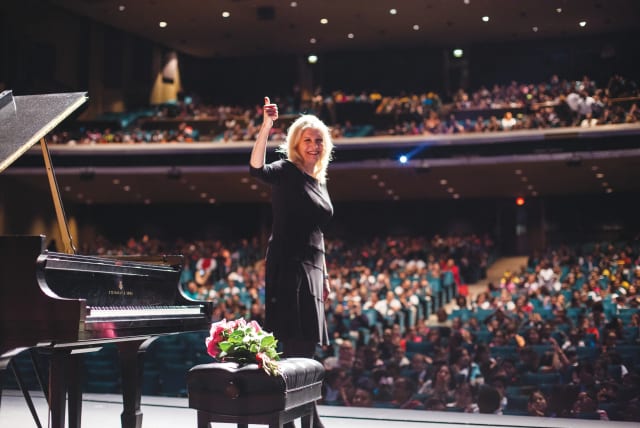In these days of ubiquitous cellphone cameras, it seems we not only find it difficult to experience events as they happen without committing an image of the proceedings to our cellphones, but we also generally feel compelled to document our own presence there. After all, if no one can see us, we might not have been there, right?
But the selfie is not a new digital age phenomenon. Far from it. English photography pioneer William Henry Fox Talbot created numerous self-portraits in the mid-19th century. And around seven decades on, Israel Isser Olstein – aka Elizur – made sure people know he’d been there and photographed that when he lugged his unwieldy camera and accessories the length and breadth of pre-state Palestine in the mid-1920s.
The results of the Lithuanian-born oleh’s documentary trips, and his own place in the snaps, are currently on show in the “Photo Watchmaker” exhibition at the Eretz Israel Museum in Ramat Aviv.
The double-barreled professional moniker sparked my interest.
Did Olstein spread his talents and skills across two trades, or was there a technical hybrid overlap in his work?
Curator Guy Raz directs me to one of the earliest items in the exhibition, from when Olstein was en route to the Promised Land in 1926. He is front and center in the frame, but this is not the result of a selfie. Or is it? How likely was it that there was another photographer on board the ship, the Asia out of Marseille, France, who took the trouble to document Olstein, in profile, behind his tripod-mounted camera?
“See this white thing?” Raz says, pointing to an odd-looking circular protuberance on the front of the camera. “That’s the timer. That’s the watchmaker in him. He created the timer and attached it to his camera. Maybe it is also a selfie. Maybe he had another camera with a timer so he could photograph himself.” Who knows?
What is clear is that Olstein took his cumbersome equipment on the road and took pictures of important spots, such as the Western Wall, a winery in Zichron Ya’acov, and the Jordan River, as well as sites and events of a more local historical interest. Today, the latter offer great documentary value. We have, for instance, an evocative picture of JNF chairman Menachem Ussishkin visiting a Scouts camp in Ben-Shemen on Lag Ba’omer on May 2, 1926. There is also a fetching group shot of Havurat Hadarom pioneers in Rishon Lezion in 1926.
Olstein certainly had a thing about showing himself to his “public.” “Out of 110 photographs in the exhibition, he appears in 105 of them,” Raz chuckles. Apparently, the man had a strong bond with his ego and was keen to ensure that no one missed the fact that he was here in the early days of the Holy Land. “I don’t know. Perhaps it was a matter of ego,” says the curator. “But I know he set the timer on 10-20 seconds, ran into a position, and caught himself in the frame. He becomes a fixture in the landscape. He positions himself within the composition in Tiberias, Ein Harod, Tel Aviv – you see him there every time.”
That, Raz observes, is a more patent expression of the more common means of asserting the photographer’s lateral presence. “Usually you see the photographer’s shadow, which they used to include themselves in the visual end product. But Olstein took it a step further.” According to Raz, it may have simply been down to his technological advantage. “He had his timer. It’s crazy.”
I wondered whether Olstein was the founding father of the camera timer mechanism. “I don’t know if he was the first, but I never saw a device like this on a camera from that initial era of photography.”
Therein lies the dual professional training edge. “He could build and install a timer because he was a watchmaker,” Raz notes. “That is what was great about what he brought to photography.”RAZ SAYS it was an important juncture in the local cultural and political continuum.
“We are looking back 100 years. Here you see the Land of Israel as it was, and as you would never see it again. It is a moment, in 1926, when you see the country as it was then.” To put that in more easily contemporary urban terms, that was before the Bauhaus architects made it here, before Tel Aviv began accruing buildings that would eventually bring it UNESCO recognition as a global architectural treasure and its White City heritage site title.
Raz believes that Olstein had at least one eye on posterity, not only his own but also the need to commit the stage of local urban, rural, human and political development to corporeal pictorial form. He was also determined to document as many places around the country as he could. The opening explanatory wall text at the museum’s Migdal Gallery includes a map of the northern half of the country, from the Lebanese border down to the Dead Sea. The chart shows the route Olstein followed, with numbers along the meandering dotted line corresponding to the various sections around the display space which help the viewer to place the photograph in question in its correct geographic context.
“He began from Tel Hai and went through the whole of the Jordan Valley,” says Raz, adding that there was also a career-advancing and financial element to his photographic logistics. “He understood that if he wanted to sell photos, he had to take pictures of the Zionist settlement program to sell to Zionists abroad.” Well, we’ve all got to eat.
That was easier said than done. Olstein did not have a motorized vehicle at his behest, nor were there too many highways at his disposal had he managed to lay his hands on an automobile. His camera was a hulking great contraption, and there was the not insignificant matter of lugging glass negatives everywhere with him, which exacerbated the load consideration. “I reckon he accomplished the whole project in four or five trips. He takes his equipment around in a cart and horse. He takes pictures at 70 places. Seventy places! He goes from Tel Hai to Rosh Pina, [Lake] Kinneret [the Sea of Galilee], [Kibbutz] Deganya, Beit She’an, and to the Jezreel Valley and Kibbutz Geva.”
Therein lies the curator’s personal vested interest – besides the pure professional-artistic value – in unveiling Olstein’s work to the public. “There’s a picture Olstein took at Geva which shows Olstein standing next to my great-grandfather,” says Raz. “It’s like having two grandfathers in the same photo – my blood relative and one of the grandfathers of photography in this country.” Not a bad “familial” confluence. Perhaps that encounter sowed the seeds for Raz’s career three generations down the line.
The exhibition is, indeed, a moving and evocative viewing experience. But where does he rate on the local photographic A-lister line? The documentary value of Olstein’s oeuvre is irrefutable, but does he rank with the best of the local lot? “Look, he’s not exactly Soskin in technical terms,” says the curator, referencing legendary Tel Aviv-based photographer Abraham Soskin, who snapped the burgeoning Jewish city in the early 20th century, as well as numerous local celebs, buildings, and, like Olstein, the spread of the Yishuv.
Olstein may not have been quite up there with the photography crème de la crème, but, Raz says, there is no doubting his documentary awareness and ability to be in the right place at the right time. “I think his photographs are charming. He understands composition. He came from Europe. He knew how to arrange a frame and, as far as we know, he was self-taught. There was no school graduation certificate.”
By all accounts, Olstein took on a mammoth venture as he wended his way around the country. With the in situ work complete, he made a few shekels – actually liras – by selling shots of local landscapes to postcard publishers. He subsequently made good use of both sets of professional skills he’d acquired when, in 1928, he opened a photographic equipment and watch repair shop on Nahalat Binyamin Street in Tel Aviv.
Amazingly, basically that was that for Olstein and photography. In 1933 Olstein and his wife, Yocheved, became members of Moshav Kfar Hess, and they became hands-on agriculturalists. Olstein locked his camera and his photographs away in a cupboard and began farming the land. When the State of Israel was founded, he changed his name to Elizur. He died in 1978.
WE MAY have never known about Olstein and his documentary travels around the country had it not been for a relative of his now 84-year-old artist friend Avraham Eilat, who came across Olstein’s wooden camera and a hoard of 300 photographs, originally printed in postcard format. Around a third of the contents of this historical treasure chest found their way into the exhibition.
Why Olstein took such pains to feature himself in his own shots remains a mystery. However, Raz discovered anecdotal evidence that the photographer did, indeed, have designs on ensuring he would not be forgotten by future generations. A caption in his handwriting appears on the back of a photograph he took during the official visit by Ussishkin to Ben-Shemen in 1926, when Olstein was taking stills of the production of the movie The Return (Veshavu Banim Ligvulam).
The lines read: “Look at the picture and see filming happening here. They are filming for the cinematograph, and I also appear in some of the scenes of the film.... If you get a chance to see the Israeli movie The Return, look out for the scenes in Ben-Shemen and see if you can pick me out, too.” So, it seems, Olstein had a mischievous side to him.
But he was meticulous when it came to making sure he had the best that current technology could offer him, even if he had to put the device together from scratch. The aforementioned timer can be viewed at close quarters, mounted on the original camera at the exhibition, courtesy of Eilat and his precious discovery.
Raz also includes some early pointers to where Olstein’s life was leading, by featuring a couple of snaps from the photographer’s pre-aliyah efforts. There are three striking frames from Olstein’s country of birth in there. “Can you see how well he photographed in Lithuania? He started including himself in his pictures back then,” Raz laughs.
There are all sorts of intriguing historical tidbits in the show. For example, the picture of the Western Wall in which the photographer appears, looking straight at the camera – evidently posed – with a couple of women among the menfolk. Supporters of the Women of the Wall activist group who trot along to the Eretz Israel Museum will no doubt enjoy that one.
‘Photo Watchmaker’ closes on April 13. For further information: www.eretzmuseum.org.il/en/exhibitions/photo-watchmaker


